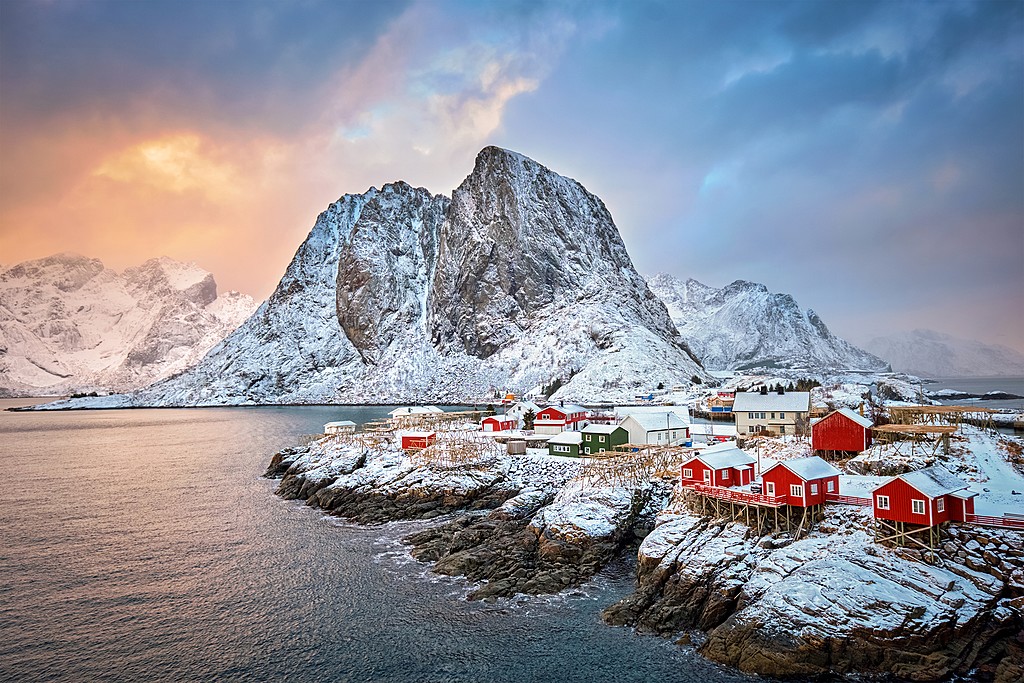Lofoten Islands in the Off-Season

In summer, the Lofoten Islands are packed to the brim. You'll try to park at Kvalvika Beach and find the lot overflowing. The hotels are booked up far, far in advance, and ferries are traveling at max capacity. Last year, these small islands saw over a million visitors!
Letting crowds determine when you visit might initially seem like a sacrifice—sweaters take up a lot of room in the luggage, after all—but it also can be much easier than heading there in the high season. The roads are open, most businesses are still operating, and the hillsides bloom with the season's respective colors. What you can expect is greatly determined by when you go, so let's dive in.
Lofoten in Spring, Autumn, and Winter

Spring in Lofoten is short, at least in terms of what most think of as "the blooming season." April is still going to be snowy, and May is really when things start getting going. The main draw to coming in spring will be the twilight nights, the warmer-than-winter weather, and the fact that everything is gearing up for summer. Hikes will still be snowy in the mountains in May, but if you stick to the coast, you should be okay.
Autumn (September and October) is a fascinating time on the islands. The weather is incredibly finicky, and it'll likely rain regularly. However, this season might also be the best for photographers. The hillsides explode in color, and light changes throughout the day, often taking on a dramatic, pre- or post-rain glow. You'll have a chance to catch the Northern Lights during this time of year, too. If your schedule is flexible and you're okay with plans changing, autumn is a great time to visit.
Winter is the longest season, lasting from November to March. January to March are the best months for that true "Lofoten in winter" look, if that's what you're after. January and February also offer interesting light, the sun taking hours to "rise" and "set." Late in winter can be good for snow activities, like skiing, as the weather is slightly more predictable and the sun is finally up and at 'em. And, of course, the fewer the daylight hours, the more chances you have to see the Northern Lights in all their glory.
Chat with a local specialist who can help organize your trip.
Things to Do

For the record, getting here — regardless of the time of year — shouldn't be an issue. Though the main ferry only runs in summer, there's still air travel and Hurtigruten. And once you're here, you're going to want to rent a car regardless. Buses are few and far between, and if you do manage to nab one, you'll be able to go to cooler places on your own.
As for things to do, Lofoten is always beautiful, and there's plenty to do if you're open to exploring new activities. Skiing, sailing, fishing, and surfing are all off-season options: Unstad has some of the best surfing anywhere, and the cod-fishing around March is a sight to see. You can also combine activities for a new take, like ski and sail tours. Trollfjord and sea eagle safaris still operate in winter, too.
Then there's the mainstays: hiking and the Northern Lights. You'll probably want to avoid hiking in spring and winter, though those times are nice for snowshoeing. The Northern Lights rage strongest around the new year, but you'll have a chance at seeing them anytime during the off-season. Light in general is worth it in winter-spring, as you get "blue hours," a sight unto themselves.
And if you're into photography, all bets are off, as your images will be that much better with fewer crowds to navigate. Here are some more tips for photography in Norway.
Road Tripping the Islands

Driving from Svolvaer to Å is an amazing experience, arguably better when there are fewer crowds and the weather is a bit nippy — you can venture outdoors to your liking, and then head back to the warmth of the car.
One of your first stops should be Henningsvaer, about 30 minutes from Svolvaer. It's one of the main fishing villages, and it's considerably less touristy than Svolvaer. It's off E10, and the detour would be worth it even without the destination. Once here, you can arrange a seafood dinner and talk with a local fisherman — it's still the main industry of the town.
The Lofotr Viking Museum is found in Borg, but note its schedule: hours are 12-3pm two days a week in the off-season. Try to swing it though, as the museum is worth a stop. Afterward, head to Unstad. Even if it's 30°F, you'll probably catch a handful of surfers shredding some of Europe's best waves — it's said the surfing here is even better in winter. This area is remarkably beautiful even for Lofoten, so be sure to spend some quality time with your camera outside the car.
Nusfjord and Ramberg are also stunning — check out the beach off E10 near the latter — and the scenery is just getting started. You're about to hit Hamnoy and Reine, two of the most iconic villages on the islands. You'll see those famous red fishing cabins (rorbuer), and if you want to stay in one, book in Hamnoy.
From here, you're almost to the end of the line at Å. The Lofoten Stockfish Museum and the Norwegian Fishing Village Museum are here, though you should check for reduced hours. A year-round ferry runs out of nearby Moskenes to Bodø, and a number of smaller fishing villages dot the area. When you're ready, head back, and do it all again. For more great road trips in Norway, take a look at this article.
